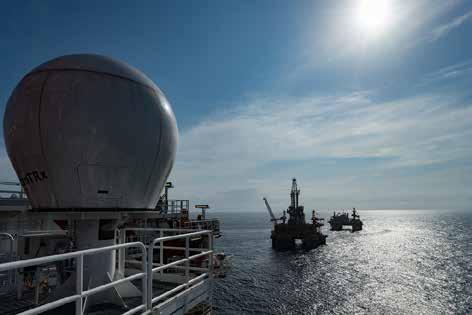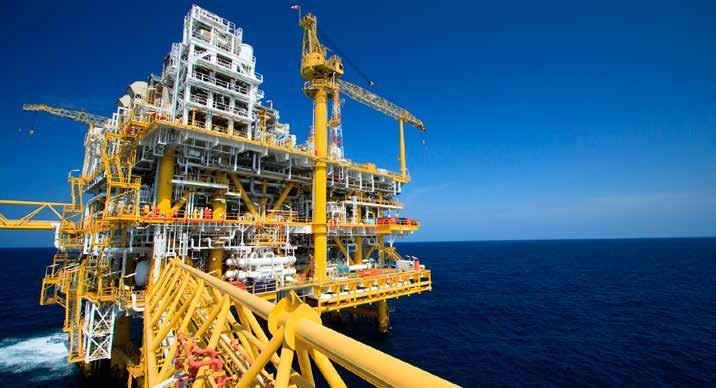
11 minute read
in November, Ben van Beurden, CEO of Shell, speaks about the global evolution underway in response to climate change and the need for the energy industry to embrace it
from IOG52
Africa’s rising stars
Oil and Gas Technology looks at the prospects of four of Africa’s rising stars in Republic of Congo, Gabon, Gambia and Namibia
Africa continues to offer abundant opportunities to explore for hydrocarbons in a frontier market. New hydrocarbon provinces are popping up regularly; Mauritania and Senegal are good examples of countries where hydrocarbons have recently been discovered. But they are not alone in providing bright hope for the hydrocarbon future of the continent.
Republic of Congo stakes its claim as gas exporter
The Republic of Congo is the fourth largest Sub-Saharan producer of oil, with an output of 277,000 bopd in 2015. Its proven oil reserves amounted to 1.6 billion barrels in 2015, with a reserves-to-production ratio of 15.8 per cent.
The prospects for the nation are improving largely thanks to Total E&P Congo’s Moho Nord project. The USD 10-billion Moho Nord project, the largest oil project in the country’s history, was launched in 2013 and has the potential to increase Congo’s production by 50 per cent to a total of 140,000 bopd. Targeted reservoirs amount to 700 million boe. After becoming a significant oil producer in the mid-1970s, Congo (Brazzaville) is now the fourth largest in sub-Saharan Africa. Most of the fields in current production are in coastal waters. The average quality of oil output has improved over the years, aided by the coming on-stream of Elf’s deep-water Nkossa field. The bulk of oil production is exported.
Total started up production from the Moho Nord deep offshore project, located 75 kilometres offshore Pointe-Noire in the Republic of the Congo, early last year. Operated by the group, the project has a production capacity of 100,000 barrels of oil equivalent per day. “Moho Nord is the biggest oil development to date in the Republic of the Congo,” Arnaud Breuillac, president, exploration and production at Total, said. “A showcase for Total’s deep offshore operational excellence, it consolidates our leading position in Africa. Moho Nord will contribute to the reinforcement of the cash flow of the group and to its production growth.” The Moho Nord field is developed through 34 wells tied back to a new tension leg platform, the first for Total in Africa, and to Likouf, a new floating production unit. The oil is processed on Likouf and then exported by pipeline to the Djeno onshore terminal, also operated by Total.
The facilities are designed to minimise their environmental footprint. There will be no routine flaring and the all-electric design improves energy efficiency by optimising the amount of power needed to run the installations. All the produced water will
Jerreh Barrow, Commissioner for Petroleum, Ministry of Petroleum and Energy, The Gambia

be reinjected into the reservoir. Total is the operator of the project with a 53.5 per cent interest. Its partners are Chevron Overseas (Congo) Limited (31.5 per cent) and Société Nationale des Pétroles du Congo (15 per cent).
But exploration and production in the nation is not only the domain of the oil and gas majors, the independents play a key role in developing the resources. One such company is Anglo African Oil & Gas (AAOG) who made a significant step in its exploration in the Republic of Congo when it spudded the TLP103 well on the Tilapia oil field in mid-August. David Sefton, executive chairman at AAOG explained that unlike the larger Democratic of Congo to the south, the Republic of Congo is a good place to work. “It is the old French Congo, now the Republic of Congo, is just to the north of the Democratic Republic of Congo,” Sefton, commented. “It’s only about five million people in a country the size of France. It is stable, decent croissants in the mornings, very French. Sometimes it’s called Congo B, Brazzaville where Congo K, Kinshasa, the south side of the river is a little more challenging place.
“It’s the oldest producing country in West Africa, so they have been going for a long time there. Currently dominated by, as you might expect, the French oil companies. Total is the biggest in that country. It has huge investments there. ENI, number two. It’s the same kind of gulf that runs all the way up the coast of Cote’d Ivoire and, Nigeria.”
Gabon sets the agenda for growth
Gabon is among the top ten oil producers in Sub-Saharan Africa and has been an oil producer for more than 50 years. It reached its peak 12 years ago when oil production reached 370,000 barrels per day to its current level of 200,000 barrels a day. To combat the natural decline of mature fields, the government has focused its attention on offshore resources which account for more than 70 per cent of the reserves. “Let me first say that Gabon is one of the safest oil producing countries in Africa and has been for a long time,” Pascal Houangni Ambouroue, the Gabonese Minister of Petroleum said at last year’s Africa Oil Week conference. “At the moment most of the oil wells that are producing are mature, which is why the Gabonese Government has put in place a set of measures such as the revisions to the Hydrocarbon Code to improve production from these mature wells and also encourage exploration and discovery of new oil in deepwater offshore.
“This will also stimulate the entry of new players with the major companies are now focussed on deep waters for production of oil and gas. Ongoing prospecting shows that Gabon has very good resources in terms of oil

and gas for the future. To combat the natural decline of mature fields, the government has focused its attention on offshore resources which account for more than 70 per cent of the reserves.”
There are currently in the region of 30 oilfields in production, making Gabon is currently the fifth largest oil producer in Africa, but production is declining. The Gabonese Government launched its tenth bidding round in late 2013 that generated eight new production sharing contracts with Marathon, Petronas, Repsol, Noble and Woodside, Impact Oil & Gas and Ophir which are all working on their exploration programmes. A further round was launched just over two years ago but the government was forced to suspend it as the low oil price and proposed economic terms failed to attract the desired interest, hence the recent amendments to the code.
The Gambia looks to oil for economic growth
According to Jerreh Barrow, Commissioner for Petroleum, Ministry of Petroleum and Energy, The Gambia, oil revenue has the potential to significantly change the economic situation of the Gambia and hence the wellbeing of Gambian.
Key to that success is the MSGBC Basin. It has been the shining light of African
exploration through the recent darkness the industry has endured. That light, or rather floodlight, was cast upon the region through the recent world-class discoveries in Senegal and Mauritania.
“The MSGBC as you know is one of the largest sedimentary basins in Africa and is also becoming one of the most prospective ones for petroleum exploration with different play types being investigated,” Barrow says. “I used investigated because the MSGBC is also one of the least explored regions and hence potentially holds many play types. Specifically speaking about The Gambia, laying in the central of the MSGBC, with discoveries to both the North and South the prospectivity is predictably high. There have been many prospects identified on trend with, and just few kilometres away from the SNE and FAN discoveries in Senegal.
“MSGBC is turning out to be beyond what was every expected in that, since the 2014 discoveries 11 successive and successful wells have been drilled in the North of the Gambia and this has caught the attention of the Petroleum industry as evidenced in the skyrocketing interest.”
The Gambia has over ten thousand square kilometres of offshore acreage and preliminary resource estimates in this is over three billion barrels of oil. It is worth mentioning that the Gambia and Senegal has long standing inextricable socio-cultural relations and bonds. In addition, there is an excellent political relationships and very well defined maritime boundaries.
“Geologically speaking, the Gambia is still at the early exploration stages of exploration with a deep offshore exploration well expected to be drilled during the later part of the year, but geologically speaking we are in a proven province,” Barrow adds. “Currently two blocks are licensed to FAR and Erin with Petronas seeking to farm into these licenses. All of this is a testimony to the prospect and conduciveness of the investment environment in The Gambia.
“Though we at an early stage in the exploration cycle, a conscious policy is being aggressively pursued to lay the foundation for creating linkages with the local economy to leverage the opportunities created by the Petroleum industry. We have included forward looking provisions in the licence agreements in anticipation of the development of the sector. The

strategy in the Gambia is a realistic and futuristic in that we are developing the local content regime in cognizant of our current realities and the state the industry should be in the future.
“Many things need to happen to optimize benefits of these potential resources. Broadly speaking good governance, strong management institutions, capacity building, robust legislative and regulatory frameworks are all critical for the optimal benefiting from the project.”
Namibia: The Last Great Frontier
“Namibia is oil and gas’s last great frontier,” Gil Holzman, president and CEO of ECO Atlantic Oil & Gas confidently proclaims. “There are other frontiers out there, but they are in more exotic areas such as the Arctic, which is very complicated. Namibia, on the other hand is much simpler, the infrastructure is already in the area.”
Interest has been mounting around the possibility of significant finds off the shore of Namibia in recent years even though only small volumes of hydrocarbon have been produced. According to the National Petroleum Corporation of Namibia (NAMCOR) on the 50 licences that have been awarded there have been
11 exploratory wells and seven appraisal wells drilled. The one success has been Brazil’s HRT who discovered oil at Wingat-1 well in the Walvis basin, but not at commercially-viable volumes.
Part of the confidence in Namibia stems from its location; surrounded by resource rich states in South Africa, Angola and Botswana. “The characteristics are quite well known,” Holzman adds. “There is oil in South Africa and Angola, there is oil the other side of the Atlantic in the Campos and Santos Basins in Brazil.”
Holzman calls Namibia Africa for beginners and a perfect place to start understanding the region. “When I go to Windhoek I feel like I am back in Zurich; it’s so clean and organised,” he adds. “It is also very stable; there have never been any problem there, it is peaceful, democratic, and stable.
It’s English speaking and they have a rule of law. It’s the second rated country in Africa, after Botswana; they are neck and neck as the

best countries in Africa to do business.
“I have operated in many other regions and the Namibian Government is one of the most supportive governments for the oil and gas industry, mainly because they leave the international players to come and explore for oil. They understand the challenges, they are very supportive and very patient. To an extent they are real partners to the industry.”
Eco Atlantic’s interests in the region are contained within the Walvis basin, a highly active but underexplored oil and gas region. In 2013 a proven offshore petroleum system was discovered by HRT and since then there has been increased activities in the region by major oil companies. Eco Atlantic has acquired four offshore licence blocks covering 23,000 km2 in the Walvis asin. The four licences are strategically positioned.
Today there are a host of major players in the basin, but that was not always the case. “When we started together with Tower, Chariot and HRT back in 2010 we proved that there are at least two active petroleum systems in offshore Namibia,” Holzman continues. “Gradually we gained more traction and came onto the radar of more of the industry players. Today in 2018 you see ExxonMobil, Total, Shell, ONGC and Tullow in the basin. The bigger names came in after the smaller companies have proved the play, and this is exactly how it should work.”
As for Eco Atlantic’s future, Holzman is adamant that there is a petroleum system in place. “The oil is there, but you must understand that it is a huge area of water; each block is between 5,000 and 10,000 square kilometres,” he explains. “Oil exploration is risky and expensive, so it takes time to de-risk the basin and understand where the oil might have been trapped and where it has migrated to. But the prize is big, we know that because of the huge structures underneath the ocean. Once someone hits oil we are talking hundreds of millions or even billions of barrels.” n






